Encoding and decoding of JSON in PHP (detailed examples)
In the previous article "Teach you how to convert arrays and strings in PHP in five minutes" we introduced in detail the relevant knowledge of converting arrays and strings in PHP. This article In this article, let’s take a look at the relevant knowledge of JSON in PHP. I hope it will be helpful to everyone!

In the previous article, we learned how to complete the conversion between arrays and strings in PHP, which requires explode() function and implode() function to implement. Next, we need to understand some knowledge of JSON and see how PHP encodes variables in JSON.
If we want to encode variables in JSON with PHP, first we need to understand what JSON is. Let's take a look at it together.
What is JSON
JSON is mainly used to transmit data. It is a lightweight data exchange format that can completely A programming language different from PHP to store and represent data.
It is relatively easy to read and write. At the same time, JSON is relatively simple for machine parsing and generation. JSON can very effectively improve the efficiency of data transmission.
We already have built-in JSON extensions in PHP. Next, let’s take a look at the JSON function in PHP and how to use the PHP language to encode JSON objects.
<strong><span style="font-size: 20px;">json_encode()</span></strong>JSON encoding
json_encode() in PHP is used to JSON encode variables. The basic syntax format of this function is as follows:
string json_encode ( $value [, $options = 0 ] )
What needs to be noted is: run json_encode( )If the function is successful, the returned result is JSON data. If there is an error, the returned result is false;
Parameter$value represents the value that needs to be encoded. The special thing about json_encode() is that only UTF-8 encoded data is valid for this function. The parameter options represents a binary mask composed of constants. These constants are: JSON_HEX_QUOT, JSON_HEX_TAG, JSON_HEX_AMP, JSON_HEX_APOS, JSON_NUMERIC_CHECK,JSON_PRETTY_PRINT, JSON_UNESCAPED_SLASHES , JSON_FORCE_OBJECT.
Next, let’s look at the use of the json_encode() function in PHP through an example, which is to convert PHP array elements into JSON format data. The example is as follows:
<?php $arr = array('a' => 1, 'b' => 2, 'c' => 3, 'd' => 4, 'e' => 5); echo json_encode($arr); $arr1 = array('一' => 1, '二' => 2, '三' => 3, '四' => 4, '五' => 5); echo json_encode($arr1); ?>
Output results:
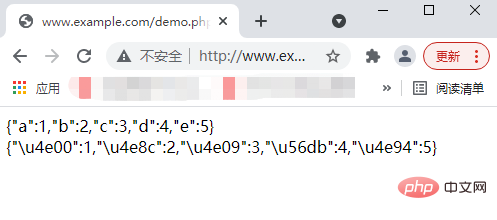
We can see from the above example that json_encode() can be used to convert PHP array elements into JSON suitable data, and only UTF-8 encoding The data is valid for this function.
The above example converts a one-dimensional array in PHP. Next, let’s take a look at the result of multi-dimensional array conversion. The example is as follows:
<?php
$arr_2 = array();
// 三维数组
$arr_2['member']['lisi']['job'] = "worker";
$arr_2['member']['lisi']['age'] = 30;
$arr_2['member']['wangwu']['job'] = "student";
$arr_2['member']['wangwu']['age'] = 10;
echo json_encode($arr_2);
//{"member":{"lisi":{"job":"worker","age":30},"wangwu":{"job":"student","age":10}}}
?>Output result:
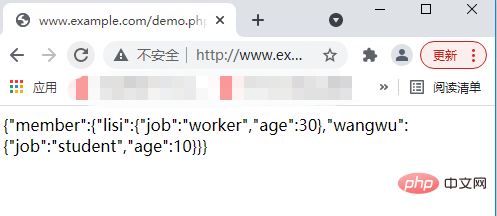
The above example is to convert array elements in PHP through functions. Next, let’s take a look at converting PHP objects into data in JSON format. The example is as follows:
<?php
class Person{
public $name = "public name";
protected $ptName = "protected name";
private $pName = "private name";
public function sayName(){
return $this->name;
}
}
$person1 = new Person();
echo json_encode($person1);//{"name":"public name"}
?>Output result:
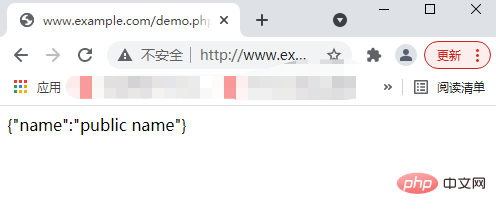
Let’s look at another example:
<?php
class Emp {
public $name = "";
public $hobbies = "";
public $birthdate = "";
}
$e = new Emp();
$e->name = "sachin";
$e->hobbies = "sports";
$e->birthdate = date('m/d/Y h:i:s a', "8/5/1974 12:20:03 p");
$e->birthdate = date('m/d/Y h:i:s a', strtotime("8/5/1974 12:20:03"));
echo json_encode($e);
?>Output result:
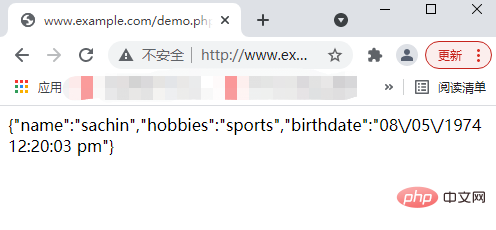
From this we complete the conversion of objects in PHP into JSON format through the json_encode() function.
<strong><span style="max-width:90%">json_decode()</span></strong>JSON decoding
In PHP, you can use the json_decode() function to convert characters in JSON format into PHP variable format, which is decoding. Let's take a look at the basic syntax format of the json_decode() function. The example is as follows:
mixed json_decode ($json [,$assoc = false [, $depth = 512 [, $options = 0 ]]])
It should be noted that the parameter json_string represents the string in JSON format that needs to be converted, that is, decoded. , like the json_encode() function, the decoded data must also be UTF-8 encoded data; the parameter assoc indicates that when the parameter is true, the returned result is an array, and when the parameter is false, The returned result is an object; the
parameter depth represents an integer type parameter, and the parameter options represents a binary mask, which is different from json_encode() However, this function currently does not support so many, and currently only supports JSON_BIGINT_AS_STRING.
Next, let’s take an example to see how PHP decodes it. The example is as follows:
<?php
$json = '{"a":1,"b":2,"c":3,"d":4,"e":5}';
var_dump(json_decode($json));
var_dump(json_decode($json, true));
?>Output result:
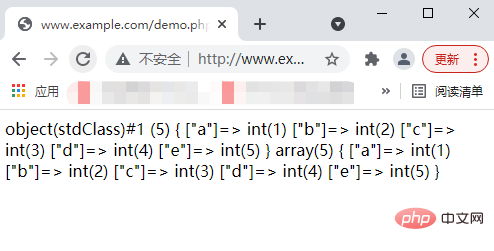
通过上述示例我们看到了通过json_decode()对JSON进行解码,上述是解码成数组,下面我们看一下解码成对象,示例如下:
<?php
$jsonStr = '{"key1":"value1","key2":"value2"}';
print_r(json_decode($jsonStr,false));//stdClass Object ( [key1] => value1 [key2] => value2
?>输出结果:

由此我们便通过json_encode()函数与json_decode()函数完成了PHP数据与JSON的编码与解码。
大家如果感兴趣的话,可以点击《PHP视频教程》进行更多关于PHP知识的学习。
The above is the detailed content of Encoding and decoding of JSON in PHP (detailed examples). For more information, please follow other related articles on the PHP Chinese website!

Hot AI Tools

Undresser.AI Undress
AI-powered app for creating realistic nude photos

AI Clothes Remover
Online AI tool for removing clothes from photos.

Undress AI Tool
Undress images for free

Clothoff.io
AI clothes remover

Video Face Swap
Swap faces in any video effortlessly with our completely free AI face swap tool!

Hot Article

Hot Tools

Notepad++7.3.1
Easy-to-use and free code editor

SublimeText3 Chinese version
Chinese version, very easy to use

Zend Studio 13.0.1
Powerful PHP integrated development environment

Dreamweaver CS6
Visual web development tools

SublimeText3 Mac version
God-level code editing software (SublimeText3)

Hot Topics
 1664
1664
 14
14
 1423
1423
 52
52
 1317
1317
 25
25
 1268
1268
 29
29
 1248
1248
 24
24
 Explain JSON Web Tokens (JWT) and their use case in PHP APIs.
Apr 05, 2025 am 12:04 AM
Explain JSON Web Tokens (JWT) and their use case in PHP APIs.
Apr 05, 2025 am 12:04 AM
JWT is an open standard based on JSON, used to securely transmit information between parties, mainly for identity authentication and information exchange. 1. JWT consists of three parts: Header, Payload and Signature. 2. The working principle of JWT includes three steps: generating JWT, verifying JWT and parsing Payload. 3. When using JWT for authentication in PHP, JWT can be generated and verified, and user role and permission information can be included in advanced usage. 4. Common errors include signature verification failure, token expiration, and payload oversized. Debugging skills include using debugging tools and logging. 5. Performance optimization and best practices include using appropriate signature algorithms, setting validity periods reasonably,
 Explain late static binding in PHP (static::).
Apr 03, 2025 am 12:04 AM
Explain late static binding in PHP (static::).
Apr 03, 2025 am 12:04 AM
Static binding (static::) implements late static binding (LSB) in PHP, allowing calling classes to be referenced in static contexts rather than defining classes. 1) The parsing process is performed at runtime, 2) Look up the call class in the inheritance relationship, 3) It may bring performance overhead.
 PHP and Python: Comparing Two Popular Programming Languages
Apr 14, 2025 am 12:13 AM
PHP and Python: Comparing Two Popular Programming Languages
Apr 14, 2025 am 12:13 AM
PHP and Python each have their own advantages, and choose according to project requirements. 1.PHP is suitable for web development, especially for rapid development and maintenance of websites. 2. Python is suitable for data science, machine learning and artificial intelligence, with concise syntax and suitable for beginners.
 PHP in Action: Real-World Examples and Applications
Apr 14, 2025 am 12:19 AM
PHP in Action: Real-World Examples and Applications
Apr 14, 2025 am 12:19 AM
PHP is widely used in e-commerce, content management systems and API development. 1) E-commerce: used for shopping cart function and payment processing. 2) Content management system: used for dynamic content generation and user management. 3) API development: used for RESTful API development and API security. Through performance optimization and best practices, the efficiency and maintainability of PHP applications are improved.
 PHP: A Key Language for Web Development
Apr 13, 2025 am 12:08 AM
PHP: A Key Language for Web Development
Apr 13, 2025 am 12:08 AM
PHP is a scripting language widely used on the server side, especially suitable for web development. 1.PHP can embed HTML, process HTTP requests and responses, and supports a variety of databases. 2.PHP is used to generate dynamic web content, process form data, access databases, etc., with strong community support and open source resources. 3. PHP is an interpreted language, and the execution process includes lexical analysis, grammatical analysis, compilation and execution. 4.PHP can be combined with MySQL for advanced applications such as user registration systems. 5. When debugging PHP, you can use functions such as error_reporting() and var_dump(). 6. Optimize PHP code to use caching mechanisms, optimize database queries and use built-in functions. 7
 The Enduring Relevance of PHP: Is It Still Alive?
Apr 14, 2025 am 12:12 AM
The Enduring Relevance of PHP: Is It Still Alive?
Apr 14, 2025 am 12:12 AM
PHP is still dynamic and still occupies an important position in the field of modern programming. 1) PHP's simplicity and powerful community support make it widely used in web development; 2) Its flexibility and stability make it outstanding in handling web forms, database operations and file processing; 3) PHP is constantly evolving and optimizing, suitable for beginners and experienced developers.
 Explain the match expression (PHP 8 ) and how it differs from switch.
Apr 06, 2025 am 12:03 AM
Explain the match expression (PHP 8 ) and how it differs from switch.
Apr 06, 2025 am 12:03 AM
In PHP8, match expressions are a new control structure that returns different results based on the value of the expression. 1) It is similar to a switch statement, but returns a value instead of an execution statement block. 2) The match expression is strictly compared (===), which improves security. 3) It avoids possible break omissions in switch statements and enhances the simplicity and readability of the code.
 PHP vs. Python: Understanding the Differences
Apr 11, 2025 am 12:15 AM
PHP vs. Python: Understanding the Differences
Apr 11, 2025 am 12:15 AM
PHP and Python each have their own advantages, and the choice should be based on project requirements. 1.PHP is suitable for web development, with simple syntax and high execution efficiency. 2. Python is suitable for data science and machine learning, with concise syntax and rich libraries.




